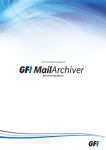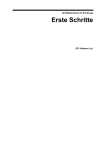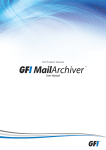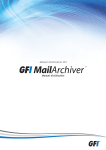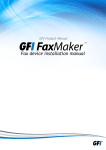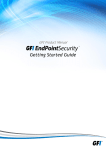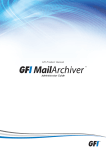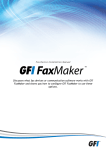Download User Manual
Transcript
GFI Product Manual User Manual http://www.gfi.com [email protected] The information and content in this document is provided for informational purposes only and is provided "as is" with no warranty of any kind, either express or implied, including but not limited to the implied warranties of merchantability, fitness for a particular purpose, and non-infringement. GFI Software is not liable for any damages, including any consequential damages, of any kind that may result from the use of this document. The information is obtained from publicly available sources. Though reasonable effort has been made to ensure the accuracy of the data provided, GFI makes no claim, promise or guarantee about the completeness, accuracy, recency or adequacy of information and is not responsible for misprints, out-of-date information, or errors. GFI makes no warranty, express or implied, and assumes no legal liability or responsibility for the accuracy or completeness of any information contained in this document. If you believe there are any factual errors in this document, please contact us and we will review your concerns as soon as practical. All product and company names herein may be trademarks of their respective owners. GFI MailArchiver is copyright of GFI SOFTWARE Ltd. - 1999-2011 GFI Software Ltd. All rights reserved. Document Version: MAR-UM-EN-2.00.00 Last updated: October 5, 2011 Contents 1 Using GFI MailArchiver 1.1 1.2 1.3 1.4 1.5 1.6 1.7 1.8 2 1 Logging in GFI MailArchiver................................................ 1 Browsing Archived Emails .................................................. 2 Working With Emails ........................................................ 3 Searching Archived Emails ................................................. 4 Email Search Using Smart Phones ........................................ 6 Accessing Multiple Mailboxes .............................................. 9 GFI MailInsights............................................................. 10 Changing User Preferences ............................................... 22 Installing GFI MailArchiver Outlook Connector 23 2.1 Installing GFI MailArchiver Outlook Connector ........................ 23 Index 25 1 Using GFI MailArchiver Read this chapter for information related to: » Logging in GFI MailArchiver » Browsing archived emails » Working with emails » Searching for archived emails » Accessing multiple mailboxes » Changing the display language 1.1 Logging in GFI MailArchiver Navigate to Start ► GFI MailArchiver ► GFI MailArchiver. GFI MailArchiver will load in your default internet browser. Key in your domain credentials (username and password used to login your Microsoft Windows installation) when prompted. Alternately, from your internet browser, key in the following URL: http://<GFI MailArchiver host name>/<GFI MailArchiver virtual folder name> For example: http://mydomain.com/MailArchiver By default, GFI MailArchiver does not require any login credentials while logging in. It will instead use the credentials of the currently logged in user. Closing your browser session logs off the currently logged on user from GFI MailArchiver. To login as a different user, log off your profile and log in using a different Microsoft Windows user. If you are logging in from a computer that is not joined to the domain where GFI MailArchiver is installed, you will be prompted to key in the credentials used to log in the domain where GFI MailArchiver is installed. GFI MailArchiver - User Guide Using GFI MailArchiver |1 1.2 Browsing Archived Emails 1. From GFI MailArchiver, select Archive tab. Screenshot 1 - Browsing Archived Emails 2. In the Archive tab, you can view emails archived for all the mailboxes that you have been granted access to. You can also perform several actions as described in Table 1 below. Table 1 - Archive tab options OPTION DESCRIPTION Enables you to search for emails. Key in the words or phrases to search for and click . Results are displayed in the emails pane. Hides the email preview pane. Shows the email preview pane. Toggles the email preview pane from displaying emails at the bottom to displaying emails at the side of the email list page. Displays emails in message view. Displays emails in mailbox view. Displays the list of mailboxes the currently logged in user has access to. From the accounts list, select the Archive Store to view mailboxes for form the List accounts in archive option. Click Close to exit Account list. 2 | Using GFI MailArchiver GFI MailArchiver – User Guide By default, GFI MailArchiver displays 25 emails per page. To change this value, click the user name displayed on the top right hand corner of your screen and change the value of the Number of emails to display per page option. Click Save. 1.3 Working With Emails Within the GFI MailArchiver Archive tab, you can view and take action on archived emails. To view an email, select the email from the mailbox or message view. This will display the selected email in the preview pane. Double click an email to view it in the email view window. Screenshot 2 - Working with emails within GFI MailArchiver GFI MailArchiver - User Guide Using GFI MailArchiver |3 In the email view window, the emails contents are displayed and several actions can be performed. These actions are listed and described in Table 2 below. Table 2 - Email view actions OPTION DESCRIPTION View email headers. Click to view email internet headers. These are displayed in a panel. Click this button again or select close to close panel. View conversation thread Click button to view the whole conversation in the mail view window. All emails forming part of the conversation are listed. Click this button again or select close to close the panel. Edit email labels (Personal and Global) Enables you to categorize emails through labelling. This feature is useful during searches for specific mail types, For example search all emails labelled as “Important”. To add a label: 1. From „Available Labels‟, key in a new email label or select an existing one. 2. Click Label Email to label email with the keyed in or selected label. To remove a previously assigned label: 1. Select a previously assigned label. 2. Click Remove label. Click this button again or select close to close panel. NOTE: Labels are displayed in the „Labels‟ field in black. Labels assigned at an organization level through categorization policies are in red. You cannot remove categorization policies labels from an email. Restore email Restores emails using the OneClick Restore feature that restores an archived email to a specific mailbox or forwards a copy to an email address. In the restore email panel, key in the email address where to send a copy of the current email and click Restore Email. Save email to disk (EML format) Downloads the whole email to disk including any attachments, in .eml format. This format is compatible with a number of email clients such as Microsoft Outlook Express, Windows Mail, and Mozilla Thunderbird. In the File download dialog box, select Save, and select the location where to save the file. Save email to disk (MSG format) Downloads the whole email to disk including any attachments, in .msg format, which is compatible with Microsoft Office Outlook. In the File download dialog box, select Save, and select the location where to save the file. Print email Displays email in a printer friendly format in a new browser window. Use the print function of your browser to print the email. Show images in email Use this button to display embedded images within the email. Mark as not SPAM Use this button to mark as not SPAM an email that was previously identified as SPAM by an anti-spam solution. Requires a SPAM retention policy to be set up 1.4 Searching Archived Emails Within GFI MailArchiver, you can search for emails using the Search Archived Emails text box. When searching for emails, GFI MailArchiver will query the email index retrieve any matching email and its respective attachment. Apart from the Search Archived Emails text box, GFI MailArchiver also provides you with an Advanced Search feature that provides an extensive range of search options. For more information on using the Advanced Search feature, refer to the Advanced Search section within this chapter. 4 | Using GFI MailArchiver GFI MailArchiver – User Guide In the Search Archived Emails text box, you can also use wildcards as described in Table 3 below. Table 3 - Wildcard description WILDCARD DESCRIPTION ? Matches any single character. * Matches any string of characters. For example: To search for emails containing the word „Swiss’, key in „sw??s‟ or „sw*s‟ in the Archived Emails text box. Emails matching the search query are displayed in the emails pane. GFI MailArchiver displays up to 25 emails per page. If more than 25 emails are matched for each search query, GFI MailArchiver will spread the emails out on separate pages. Use the slider at the bottom of the email pane to change from one page to the next. 1.4.1 Advanced Search The Advanced Search is an extension of the Search feature that enables you to use a wide range of search criteria when searching for emails. 1. From the Archive tab, select . Screenshot 3 - Advanced Search Options 2. In the Advanced Search Options area, use the features described in Table 4 below to perform an advanced search. Table 4 - Advanced Search options OPTION DESCRIPTION Archive Store Defines the Archive Store where the search will be performed. Select one or more Archive Stores from the available list of Archive Stores. Sent date Defines the date when the email to search for was sent. Includes all/any Defines whether to display emails that match all conditions or emails that match any of the conditions. From the drop-down list select: » » GFI MailArchiver - User Guide All – Displays emails that match at least one of the conditions specified. Any – Displays emails that meet all the conditions specified. Using GFI MailArchiver |5 OPTION DESCRIPTION Click this button to add conditions. Available conditions are: » » Subject – Search for emails having a specific subject. » Recipient - Specify the email address or Active Directory display name of the email recipient for which to search emails. » Sent Date - Search for emails sent before, after or exactly on a specific date. Key in or select a date, and select Is before, Is after or Is exactly. » Received Date - Search for emails received before, after or exactly on a specific date. Key in or select a date, and select Is before, Is after or Is exactly. » Size (KB) - Search for emails that are bigger, smaller or equal to a particular size. Key in a size and select Is greater than, Is smaller than and Is exactly. » Message ID - Search using the „Message ID‟ field contained in the email header. Key in or paste the message ID of the email to find. » Whole Email - Search for emails that have some specific content anywhere in the email (including the body, headers and attachments). » » Body - Search for emails that have some specific content in the body. » » Folder - Search for emails contained in a specific mailbox folder. Sender - Specify the email address or Active Directory display name of the email sender for which to search emails. Attachment - Search for emails that have some specific content anywhere in the attachment. Folder/Subfolders - Search for emails contained in a specific subfolder within a mailbox folder. » Label - Search for emails labeled with a specific label. NOTE: Click displayed next to a search condition to remove it. Exclude emails with the following conditions Defines a list of conditions that the email will NOT have to meet to be returned as a search result. Click and select the conditions to apply. The conditions that can be selected are similar to the ones described above. NOTE: Click displayed next to a search criteria to remove it from search. Search Starts the search for the archived emails. Results are returned as per the conditions selected. Reset Resets the search conditions and enables you to start all over again. Save Saves the search conditions as a saved search query that can be triggered at any time. 1.5 Email Search Using Smart Phones Within GFI MailArchiver, you can search for emails using a smart phone. This feature is supported by the following mobile Operating Systems: » Android 2.1+ » Apple iPhone iOS 4 » Blackberry OS5+ To perform a simple search: 1. Launch the Internet browser on your smart phone and key in the URL where GFI MailArchiver is located in the following format: http://<GFI MailArchiver host name>/<GFI MailArchiver virtual folder name> For example: http://mydomain.com/MailArchiver 6 | Using GFI MailArchiver GFI MailArchiver – User Guide Screenshot 4 - Smart Phone Login Screen 2. Sign in using your credentials. Screenshot 5 - GFI MailArchiver Home Page for Smart Phones The Mobile User Interface uses the same language settings as those configured by the user in GFI MailArchiver. For more information on how to change the language of GFI MailArchiver, refer to Changing User Preferences section. GFI MailArchiver - User Guide Using GFI MailArchiver |7 3. Key in the text to search for and click Search. Screenshot 6 - Search Result by Smart Phone 4. Browse through the displayed results using the controls provided. Results are sorted by date in descending order. The mobile search feature returns 10 emails per page. You can browse additional pages using the controls provided. The maximum number of results is 5000. 8 | Using GFI MailArchiver GFI MailArchiver – User Guide Screenshot 7 – Conversation View Smart Phone 5. Click the Email subject to display the email or click View Conversation to display related emails. The mobile user interface is focused on searching email archives. For advanced search and browsing features, access GFI MailArchiver from your computer. The mobile user interface enables users to access ONLY their mailbox. 1.6 Accessing Multiple Mailboxes From within the Archive tab, you can also browse other users‟ archived emails. The users for which you can access emails depend on the access granted from the GFI MailArchiver Access Control feature. Search user to add feature is disabled if currently logged on user does not have access to other user‟s mailboxes, or if there are no emails to view. Screenshot 8 - Accessing multiple mailboxes To view archived emails for a different mailbox: 1. Key in the name of the mailbox for which to view emails in the Search users to add search box . A list of names matching the one keyed and for which you have access to will be displayed. 2. Select the user and click next to the search field. 3. Select the newly added user from the Browse conversations for: field. GFI MailArchiver - User Guide Using GFI MailArchiver |9 4. Browse or search the displayed emails using the controls provided. 1.7 GFI MailInsights GFI MailInsights is a reporting facility within GFI MailArchiver that leverages archived emails to deliver information related to email usage and trends. Use this feature to generate management and HR reports that provide insight on email and resource use or misuse. GFI MailInsights is only enabled for users with full access rights. For further information refer to: Adding Groups to the Full Access Group in the GFI MailArchiver Administration and Configuration Manual. The available reports are: » Communication Flow – Monitor user/group communication patterns inside and outside the organization. » WebMail Use - Identify top users exchanging email with webmail services. Identifies potential data leakages and inappropriate email use. » Email Responsiveness - Gain insight into the average time it takes users to reply to internal and external email. » Storage Use - Understand the impact of attachments on email storage costs. Use this report to create appropriate retention policies to control email-related storage space. » Inactive Accounts - Returns a list of user accounts that received email but have not replied within the specified time. » Inappropriate Words - Track inappropriate language in email that violates company policy. Generating Reports Generated reports are sent by email to logged in user (as an attachment in PDF format). To generate a report: 1. Select MailInsights tab and choose desired report. 2. Use available filters by selecting a value to filter by. 3. Click Generate Report, located at the bottom of each report page. 10 | Using GFI MailArchiver GFI MailArchiver – User Guide 1.7.1 Communication Flow The Communication Flow graph provides an overview of emails exchanged between selected users/groups and their contacts. Screenshot 9 – MailInsights Communication Flow Filter the report using the following criteria: Table 5 – Communication Flow Report criteria OPTION DESCRIPTION Scope Specify date range or use default setting. You can only select dates in the last 6 months. Report for Select Active Directory user or group. Recipients Select Internal, External or All. Include Specify number of results up to a maximum of 1000 recipients. Default value is Top 20. GFI MailArchiver - User Guide Using GFI MailArchiver |11 Screenshot 10 – MailInsights Communication Flow Report Senders can be a user or group displayed as a single entity in the middle of the report. Contacts are segregated by domains. Each domain cluster is shown in different color. Edge width between the nodes shows the strength of the email relation between different entities. The table below the graph shows the following information: Table 6 – Communication Flow Report criteria OPTION DESCRIPTION Contact Email Contact email address 12 | Using GFI MailArchiver GFI MailArchiver – User Guide OPTION DESCRIPTION Sent Emails Total number of sent emails Received Emails Total number of received emails Total Emails Total number of sent and received emails Last Communication Date and time of last sent/received email. 1.7.2 WebMail Use The WebMail Use area enables you to generate a report that shows interaction of internal users with web email accounts. Screenshot 11 – MailInsights WebMail Communicators The report can be filtered using the following criteria: Table 7 – WebMail Communicators Report criteria OPTION DESCRIPTION Scope Specify date range or use default setting. You can only select dates in the last 6 months. Report for Select Active Directory user or group. Include Specify number of results up to a maximum of 1000 recipients, default value is Top 20. GFI MailArchiver - User Guide Using GFI MailArchiver |13 Screenshot 12 – MailInsights WebMail Communicators Report The line graph represents total emails sent and received in specified period. A Summary area at the top of the report shows the top WebMail providers, with a summary of sent and received emails per provider. The table below the graph contains the following information: Table 8 – Communication Flow Report criteria OPTION DESCRIPTION User User email address. Total Emails Total number of internal contacts. Sent Emails Total number of sent emails. Received Emails Total number of received emails. Average/Day Average emails sent and received per day. Total Percentage Percentage of total web emails. WebMail Use report covers the following webmail providers: Hotmail; Gmail; Yahoo!; Live; AOL; Facebook; Yandex.ru; Seznam.cz; Gawab.com; Gmx.com; Mail.ru; Hushmail.com; Rediff.com 14 | Using GFI MailArchiver GFI MailArchiver – User Guide 1.7.3 Email Responsiveness The Email Responsiveness report shows how long it takes employees to reply to emails. Screenshot 13 – MailInsights Email Responsiveness Filter the report using the following criteria: Table 9 – WebMail Communicators Report criteria OPTION DESCRIPTION Scope Specify date range or use default setting (Last 7 days). You can only select dates in the last 6 months. Report for Select Active Directory user or group. Include Specify number of results up to a maximum of 1000 recipients, default value is All. Sort By Specify sorting method. Options are: » By name (default) » By responsiveness GFI MailArchiver - User Guide Using GFI MailArchiver |15 Screenshot 14 – MailInsights Email Responsiveness Report The bar chart represents users on the y-axis and responsiveness in hours on the x-axis. Data is sorted according to defined criteria. Additional data is displayed in a table below the chart with the following information: Table 10 – Communication Flow Report criteria OPTION DESCRIPTION User Name or email address of user Average responsiveness All Email (Hours) Average Internal responsiveness Internal Email (Hours) Average external responsiveness External Email (Hours) 16 | Using GFI MailArchiver GFI MailArchiver – User Guide 1.7.4 Storage Use The Email Storage report shows how much space is used by different attachment categories. Screenshot 15 – MailInsights Email Storage Usage Filter report using the following criteria: Table 11 – Email Storage Report criteria OPTION DESCRIPTION Scope Specify date range or use default setting (This Month). You can only select dates in the last 6 months. Report for Select Everyone (default), Active Directory user or group GFI MailArchiver - User Guide Using GFI MailArchiver |17 Screenshot 16 – MailInsights Email Storage Report The graph consists of stacks representing different attachment categories. The graph‟s xaxis shows the different size brackets and the y-axis shows the attachment size. Attachment categories for Email Storage report are: Images, Documents, Music, Videos and Others The table below the graph contains the following additional information: Table 12 – Email Storage Report criteria OPTION DESCRIPTION Date Date email was received. Total Size (KB) Total size of attachment. Images (KB) Total size of attachment for category Images. Documents (KB) Total size of attachment for category Documents. Music (KB) Total size of attachment for category Music. Videos (KB) Total size of attachment for category Videos. Other (KB) Total size of attachment for category Other. 18 | Using GFI MailArchiver GFI MailArchiver – User Guide 1.7.5 Inactive Accounts The Inactive Accounts area enables you to generate a report that shows internal accounts that are no longer active. Screenshot 17 – MailInsights Inactive Accounts Filter report using the following criteria: Table 13 – Inactive Accounts Report criteria OPTION DESCRIPTION Scope Specify date range or use default setting (Last 30 days). You can only select dates in the last 6 months. Screenshot 18 – Inactive Accounts Report GFI MailArchiver - User Guide Using GFI MailArchiver |19 An inactive account is an account that has received emails but has not sent any emails in the date range covered. The report returns a list of inactive accounts. 1.7.6 Inappropriate Words The Inappropriate Words area enables you to generate a report that identifies any inappropriate language used in emails. Inappropriate words can include words considered sexist, racist or swear words. Screenshot 19 – MailInsights Inappropriate Words Filter the report using the following criteria: Table 14 – Inappropriate Words Report criteria OPTION DESCRIPTION Scope Specify date range or use default setting (Today). You can only select dates in the last 6 months. Recipients Select All, Internal Only, External Only 20 | Using GFI MailArchiver GFI MailArchiver – User Guide Screenshot 20 – MailInsights Inappropriate Words Report Report data is displayed in a table listing the following: Table 15 – Email Storage Report criteria OPTION DESCRIPTION Date/Time Email date and time Sender Sender email address Subject Email subject GFI MailArchiver - User Guide Using GFI MailArchiver |21 1.8 Changing User Preferences 1. Click the user name displayed on the upper right hand corner of the screen. Screenshot 21 - User profile preferences 2. From the Language options drop down box, select the language to display. 3. From the Maximum page size area, configure the number of emails to display per page. 4. From the Audit Reports Date/Time Format area (available only if logged in as an administrator), change the date/time format to display on audit reports. 5. Click Save. 22 | Using GFI MailArchiver GFI MailArchiver – User Guide 2 Installing GFI MailArchiver Outlook Connector The GFI MailArchiver Outlook Connector enables users to synchronize their Microsoft Outlook folders with the data archived by GFI MailArchiver. 1. Click Outlook Connector tab. 2. Select one of the available download options link to download GFI MailArchiver Outlook Connector. Available options are: OPTION DESCRIPTION Outlook Connector (32bit Outlook) Download the GFI MailArchiver Outlook Connector for Microsoft Outlook 32bit version. Outlook Connector (64bit Outlook) Download the GFI MailArchiver Outlook Connector for Microsoft Outlook 64bit version. 2.1 Installing GFI MailArchiver Outlook Connector 1. Select Outlook Connector tab and download: » MAROC_32bitOutlook.exe (Installer for Microsoft Outlook 32-bit) » MAROC_64bitOutlook.exe (Installer for Microsoft Outlook 64-bit) 2. Double click on the file and follow the wizard to install To check installation, from Microsoft Outlook, check that a new folder called GFI MailArchiver Mailbox is created. For information on how to use the GFI MailArchiver Outlook Connector, refer to the GFI MailArchiver Outlook connector manual available from: http://www.gfi.com/mar/manual/ GFI MailArchiver - User Guide Installing GFI MailArchiver Outlook Connector |23 Index A H Access Control, 10 headers, 4, 6 Active Directory, 6 archive, 2, 5 C categorization policies, 4 G O OneClick, 4 OneClick Restore, 4 R recipient, 6 GFI MailArchiver Outlook Connector, 25 GFI MailArchiver - User Guide Index | 25 USA, CANADA AND CENTRAL AND SOUTH AMERICA 15300 Weston Parkway, Suite 104 Cary, NC 27513, USA Telephone: +1 (888) 243-4329 Fax: +1 (919) 379-3402 [email protected] ENGLAND AND IRELAND Magna House, 18-32 London Road, Staines, Middlesex, TW18 4BP, UK Telephone: +44 (0) 870 770 5370 Fax: +44 (0) 870 770 5377 [email protected] EUROPE, MIDDLE EAST AND AFRICA GFI House, San Andrea Street, San Gwann, SGN 1612, Malta Telephone: +356 2205 2000 Fax: +356 2138 2419 [email protected] AUSTRALIA AND NEW ZEALAND 83 King William Road, Unley 5061, South Australia Telephone: +61 8 8273 3000 Fax: +61 8 8273 3099 [email protected] Disclaimer © 2011. GFI Software. All rights reserved. All product and company names herein may be trademarks of their respective owners. The information and content in this document is provided for informational purposes only and is provided “as is” with no warranty of any kind, either express or implied, including but not limited to the implied warranties of merchantability, fitness for a particular purpose, and non-infringement. GFI Software is not liable for any damages, including any consequential damages, of any kind that may result from the use of this document. The information is obtained from publicly available sources. Though reasonable effort has been made to ensure the accuracy of the data provided, GFI makes no claim, promise or guarantee about the completeness, accuracy, recency or adequacy of information and is not responsible for misprints, out- of-date information, or errors. GFI makes no warranty, express or implied, and assumes no legal liability or responsibility for the accuracy or completeness of any information contained in this document. If you believe there are any factual errors in this document, please contact us and we will review your concerns as soon as practical.































